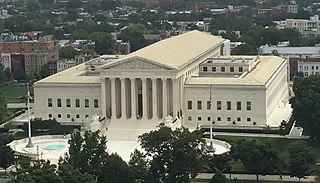
Some of the states that do have intermediate appellate courts have more than one, such as Alabama, which has one intermediate appellate court for civil matters and another for criminal, and Pennsylvania, with a Superior Court and a Commonwealth Court which are both appellate courts but with different subject-matter jurisdictions.
Of the states with intermediate appellate courts, some have many divisions with varying degrees of independence from each other.
| Court | Number of judges | Established |
|---|---|---|
| Alabama Court of Civil Appeals | 5 | 1969 [1] |
| Alabama Court of Criminal Appeals | 5 | 1969 [1] |
| Alaska Court of Appeals | 4 | 1980 |
| Arizona Court of Appeals | 22 | 1965 [2] |
| Arkansas Court of Appeals | 12 | 1978 |
| California Courts of Appeal | 105 | 1905 |
| Colorado Court of Appeals | 22 | 1891 [3] |
| Connecticut Appellate Court | 10 | 1982 |
| Florida District Courts of Appeal | 71 | 1957 |
| Georgia Court of Appeals | 12 | 1906 |
| Hawaii Intermediate Court of Appeals | 6 | 1979 |
| Idaho Court of Appeals | 4 | 1982 |
| Illinois Appellate Court | 54 | 1877 |
| Indiana Court of Appeals | 15 | 1891 |
| Iowa Court of Appeals | 9 | 1976 [4] |
| Kansas Court of Appeals | 12 | 1977 |
| Kentucky Court of Appeals | 14 | 1975 [5] |
| Louisiana Circuit Courts of Appeal | 54 | 1879 [6] |
| Appellate Court of Maryland | 13 | 1966 |
| Massachusetts Appeals Court | 25 | 1972 |
| Michigan Court of Appeals | 28 | 1963 |
| Minnesota Court of Appeals | 19 | 1983 |
| Mississippi Court of Appeals | 9 | 1995 |
| Missouri Court of Appeals | 32 | 1972 [7] |
| Nebraska Court of Appeals | 6 | 1991 |
| Nevada Court of Appeals | 3 | 2014 |
| New Jersey Superior Court, Appellate Division | 32 | 1947 |
| New Mexico Court of Appeals | 10 | 1965 |
| New York Supreme Court, Appellate Division | 60 | 1896 |
| North Carolina Court of Appeals | 15 | 1967 |
| North Dakota Court of Appeals | 3 | 1987 |
| Ohio District Courts of Appeal | 68 | 1912 [8] |
| Oklahoma Court of Civil Appeals | 12 | 1970 |
| Oregon Court of Appeals | 13 | 1969 [9] |
| Pennsylvania Superior Court | 15 | 1895 |
| Pennsylvania Commonwealth Court | 9 | 1968 |
| South Carolina Court of Appeals | 9 | 1983 |
| Tennessee Court of Appeals | 12 | 1925 |
| Tennessee Court of Criminal Appeals | 12 | 1925 |
| Texas Court of Appeals | 80 | 1891 |
| Utah Court of Appeals | 7 | 1987 |
| Virginia Court of Appeals | 17 | 1985 |
| Washington Court of Appeals | 22 | 1969 [10] |
| West Virginia Intermediate Court of Appeals | 3 | 2021 |
| Wisconsin Courts of Appeal | 16 | 1978 |

An appellate court, commonly called a court of appeal(s), appeal court, court of second instance or second instance court, is any court of law that is empowered to hear an appeal of a trial court or other lower tribunal. In much of the world, court systems are divided into at least three levels: the trial court, which initially hears cases and reviews evidence and testimony to determine the facts of the case; at least one intermediate appellate court; and a supreme court (or court of last resort) which primarily reviews the decisions of the intermediate courts, often on a discretionary basis. A particular court system's supreme court is its highest appellate court. Appellate courts nationwide can operate under varying rules.
In the United States, a state supreme court is the highest court in the state judiciary of a U.S. state. On matters of state law, the judgment of a state supreme court is considered final and binding in both state and federal courts.
In the United States, a state court has jurisdiction over disputes with some connection to a U.S. state. State courts handle the vast majority of civil and criminal cases in the United States; the United States federal courts are far smaller in terms of both personnel and caseload, and handle different types of cases. States often provide their trial courts with general jurisdiction and state trial courts regularly have concurrent jurisdiction with federal courts. Federal courts are courts of limited jurisdiction and their subject-matter jurisdiction arises only under federal law.
Post-1891 U.S. appellate circuit courts" />
The United States courts of appeals are the intermediate appellate courts of the United States federal judiciary. They hear appeals of cases from the United States district courts and some U.S. administrative agencies, and their decisions can be appealed to the Supreme Court of the United States. The courts of appeals are divided into 13 "Circuits". Eleven of the circuits are numbered "First" through "Eleventh" and cover geographic areas of the United States and hear appeals from the U.S. district courts within their borders. The District of Columbia Circuit covers only Washington, DC. The Federal Circuit hears appeals from federal courts across the United States in cases involving certain specialized areas of law.
In law, certiorari is a court process to seek judicial review of a decision of a lower court or government agency. Certiorari comes from the name of an English prerogative writ, issued by a superior court to direct that the record of the lower court be sent to the superior court for review. The term is Latin for "to be made more certain", and comes from the opening line of such writs, which traditionally began with the Latin words "Certiorari volumus. ".
The Appellate Division of the Supreme Court of the State of New York is the intermediate appellate court in New York State. The state is geographically divided into four judicial departments of the Appellate Division. The full title of each is, using the "Fourth Department" as an example, the "Supreme Court of the State of New York, Appellate Division, Fourth Judicial Department".
The Supreme Court of the State of New York is the trial-level court of general jurisdiction in the New York State Unified Court System. It is vested with unlimited civil and criminal jurisdiction, although in many counties outside New York City it acts primarily as a court of civil jurisdiction, with most criminal matters handled in County Court.
Circuit courts are court systems in several common law jurisdictions. It may refer to:

The Supreme Court of Maryland is the highest court of the U.S. state of Maryland. The court, which is composed of one chief justice and six associate justices, meets in the Robert C. Murphy Courts of Appeal Building in the state capital, Annapolis. The term of the Court begins the second Monday of September. The Court is unique among American courts in that the justices wear red robes.
The judiciary of Australia comprises judges who sit in federal courts and courts of the States and Territories of Australia. The High Court of Australia sits at the apex of the Australian court hierarchy as the ultimate court of appeal on matters of both federal and State law.
The structure of the judiciary of Texas is laid out in Article 5 of the Constitution of Texas and is further defined by statute, in particular the Texas Government Code and Texas Probate Code. The structure is complex, featuring many layers of courts, numerous instances of overlapping jurisdiction, several differences between counties, as well as an unusual bifurcated appellate system at the top level found in only one other state: Oklahoma. Municipal Courts are the most active courts, with County Courts and District Courts handling most other cases and often sharing the same courthouse.
The United States territorial courts are tribunals established in territories of the United States by the United States Congress, pursuant to its power under Article Four of the United States Constitution, the Territorial Clause. Most United States territorial courts are defunct because the territories under their jurisdiction have become states or been retroceded.
Highest court in the U.S. state of Texas for civil appeals" />
The Supreme Court of Texas is the court of last resort for civil matters in the U.S. state of Texas. A different court, the Texas Court of Criminal Appeals, is the court of last resort in criminal matters.
The Oregon Court of Appeals is the state intermediate appellate court in the US state of Oregon. Part of the Oregon Judicial Department, it has thirteen judges and is located in Salem. Except for death penalty cases, which are reserved to the Oregon Supreme Court, and tax court cases, it has jurisdiction to hear all civil and criminal appeals from Oregon circuit courts, and to review actions of most state administrative agencies. The 13 judges of the court are chosen by the people in statewide nonpartisan elections to six-year terms, and have as their administrative head a Chief Judge appointed from their number by the Chief Justice of the state Supreme Court.
The District Court of Guam is a United States territorial court with jurisdiction over the United States territory of Guam. It sits in the capital, Hagåtña. Appeals of the court's decisions are taken to the United States Court of Appeals for the Ninth Circuit. It is not an Article III court, and therefore its judges do not have life tenure, but are appointed to ten-year terms.

The Oregon Judicial Department (OJD) is the judicial branch of government of the state of Oregon in the United States. The chief executive of the branch is the Chief Justice of the Oregon Supreme Court. Oregon’s judiciary consists primarily of four different courts: the Oregon Supreme Court, the Oregon Tax Court, the Oregon Court of Appeals, and the Oregon circuit courts. Additionally, the OJD includes the Council on Court Procedures, the Oregon State Bar, Commission on Judicial Fitness and Disability, and the Public Defense Services Commission. Employees of the court are the largest non-union group among state workers.
In law, an appeal is the process in which cases are reviewed by a higher authority, where parties request a formal change to an official decision. Appeals function both as a process for error correction as well as a process of clarifying and interpreting law. Although appellate courts have existed for thousands of years, common law countries did not incorporate an affirmative right to appeal into their jurisprudence until the 19th century.
The judiciary of Michigan is defined under the Michigan Constitution, law, and regulations as part of the Government of Michigan. The court system consists of the Michigan Supreme Court, the Michigan Court of Appeals as the intermediate appellate court, the circuit courts and district courts as the two primary trial courts, and several administrative courts and specialized courts. The Supreme Court administers all the courts. The Michigan Supreme Court consists of seven members who are elected on non-partisan ballots for staggered eight-year terms, while state appellate court judges are elected to terms of six years and vacancies are filled by an appointment by the governor, and circuit court and district court judges are elected to terms of six years.
This page is based on this Wikipedia article
Text is available under the CC BY-SA 4.0 license; additional terms may apply.
Images, videos and audio are available under their respective licenses.